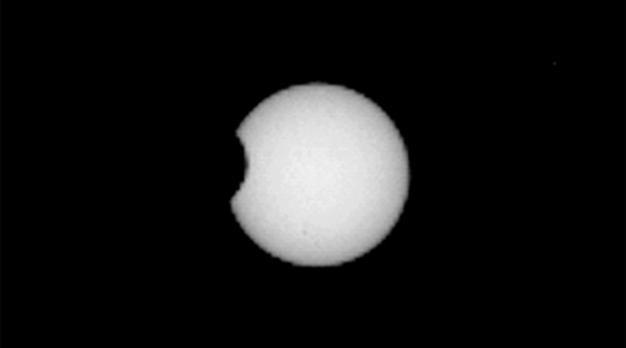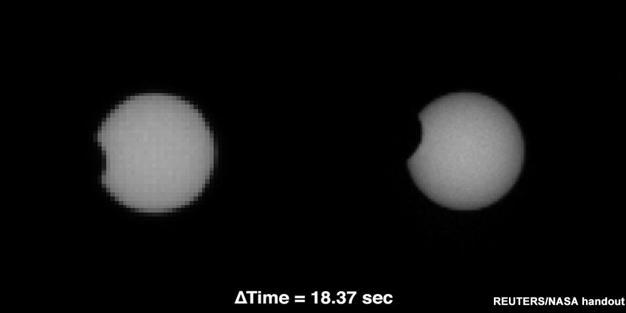Solar eclipse on Mars captured by NASA's Curiosity
WASHINGTON - The Associated Press

In this Thursday, Sept. 13, 2012 photo made available by NASA, the Martian moon Phobos grazes the sun's disk as seen by the Curiosity rover. AP photo
On Mars, a partial eclipse of the sun isn’t quite as rare as on Earth. So NASA’s Mars Curiosity rover is snapping hundreds of pictures of the spectacle for the folks back home to ooh and aah over.Two moons zip around the red planet and they’re closer and faster than our lumbering moon, so eclipses are more common. Scientists say there’s even somewhat of an eclipse season on Mars, and it’s that time of year when those Martian moons take turns taking bites of the sun.
Curiosity turned its cameras skyward to watch the action in three different eclipses, starting last week and continuing Wednesday, when a moon partially slipped between Mars and the sun.
The rover has been beaming back a stream of photos of the Martian landscape since landing near the equator last month.
Texas A&M University scientist Mark Lemmon said the eclipse pictures will help scientists track the fate of the larger Martian moon, Phobos, which is slowing down in its orbit around Mars. In 10 to 15 million years, Phobos will get so close to Mars it will break up and crash into the planet.
These moons aren’t mere curiosity factors. They get so close to Mars that "they change Mars’ shape ever so slightly" with their pull, Lemmon said.

Past rovers have taken pictures of solar eclipses from Mars, but not with such good cameras that take high resolution photos and so many shots that it produces a movie of sorts, Lemmon said.
And now that Curiosity has gazed skyward, it’s time for the Mini Cooper-sized spacecraft to focus on the ground. On Friday, Curiosity will test its first rock with a laser and other chemical testing kits on the end of its robotic arm.
Its first target is a pyramid-shaped dark rock, about 10 inches tall and 16 inches wide at the base. Two of the arm’s chemical-sniffing devices will snuggle up against the rock - named for Jake Matijevic, a Mars rover engineer who died recently - so scientists can figure out what it is made of.
"It’s just a cool looking rock sitting out there on the plains," said Mars Science Laboratory scientist John Grotzinger. But it’s not that unusual and seems similar to rocks past rovers have tested before. That makes it a good start for the rover’s testing equipment.
It’s the type of rock that is scattered all over Mars probably blown out of a crater when it was hit by an asteroid or something, Grotzinger said.
















